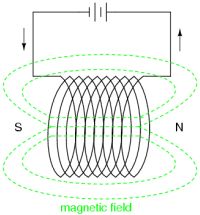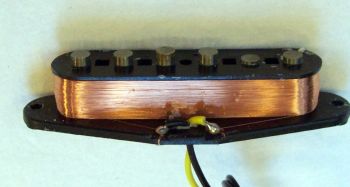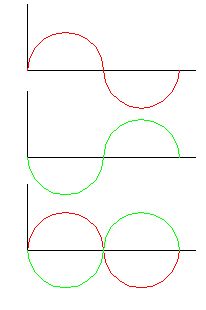|
Electric Guitar Pickups.
Electric guitar pickups are nothing more than some wire wrapped around a magnet. Now as simple as that sounds, how much wire, what gauge of wire, what type of magnet, etc. is the real art of designing pickups that are more or less pleasing to the player.
There are two basic types of guitar pickup available. The single coil electric guitar pickup, which is the foundation of the Fender Stratocaster, and is still widely used today. And the dual coil guitar pickup, better known as the humbucker, which is widely used by Gibson on their Les Pauls, and SGs, for example. The electric pickup is very similar in function to the alternator in your car. The pickup takes kinetic energy, created by you plucking a steel string, and turns it into electrical energy. The engine in your car provides kinetic energy, and your alternator turns it into electrical energy. Both the pickup, and the alternator, create energy by passing a magnetic, or ferrous, material through a magnetic field. The alternator does this rotationally with an armature, and you do it by plucking or picking a steel string, creating vibration, over a wound magnet, . The electrical current produced varies in frequency depending on the frequency of the string. It also varies in magnitude depending on how hard the string is picked. All magnets, like batteries, are polarized. Batteries have a positive and a negative side, and magnets have a north and a south pole. If you’ve ever experimented with magnets, say in science class, you realize that two magnets will attract if oriented a certain way, and will repel if oriented in reverse. This is because a north pole will attract a south pole of another magnet, and two north, or south poles will repel each other. This is important for a couple of reasons. When building a single coil electric guitar pickup, the six magnets(or poles, some pickups have bar magnets underneath) that you see protruding through the pickup cover must be oriented in the same direction. When building a Gibson style humbucker pickup, the magnets in the two adjacent windings must be oriented opposite to one another, one set of six must point up south, the other set of six must point up north. You can easily check the orientation of a magnet with a compass. Put the compass near your pickup, if the north pointer points towards your pickup, the magnets are oriented north up, if it points away, the magnets are oriented south. If you own a strat with single coil electric guitar pickups, you will most likely find that the middle pickup has it’s magnets oriented opposite to the bridge and neck pickups. This is because the middle pickup is wound in reverse of the neck and bridge. When you place your strat in either position two or four, the neck and the middle pickups, and the middle and the bridge pickups, respectively, act as a humbucker. We are surrounded by electro-magnetic fields, predominately 50-60 hz fields because that is the frequency of the alternating current produced by our power companies(mostly 60hz, 50hz was/is used in more industrial applications) in the states. This frequency can wreak havoc on all kinds of electronic equipment. And it’s the predominant cause of that hum you hear from a single coil pickup. Electric fields infiltrate the coil of the pickup, and produce a current that results in a hum. You can shield the cavity of your guitar, as I did here, or take advantage of the multitude of stacked humbucker pickups that are made to fit into the space used by a single coil pickup. The humbucker works by using two coil windings, of equal size, that are wound opposite of one another. What happens is this, when that irritating 50-60 hz magnetic field enters the coils, the signal it creates in each coil is moving in the opposite direction of one another, when the two signals meet on the signal path they cancel one another out, effectively “bucking” the “hum”. The sketch below shows two sine waves, red and green. These two waves are what you would see if you placed each coil of the humbucker on an oscilloscope. These two waves are 180 degrees out of phase. When the signals combine, they cancel each other.
The signal generated from the string isn’t canceled, because the magnets in each pickup are installed so their poles are reversed. This in turn amplifies the signal, because the string signal is increased due to both signals being in phase, and actually summing, while the hum is canceled. A beautiful thing if you ask me. 
The reason the humbucker amplifies the guitar signal, while cancelling the hum, is better described by the diagram to the left. Note that a coil of wire with a DC power source creates a south pole on the negative side, and a north pole on the positive side, with the current flowing south to north. Similarly if you orient the magnetic poles opposite to one another in a humbucker electric guitar pickup, with the coils reversely wound, the signal will be in phase with one another, thus will sum. I’m going to get into wiring variations of the humbucker, and their resulting tones, in another segment. It’s important to note though that a stacked humbucker is fundamentally different than the side-by-side humbuckers found in Les Pauls, or fat strats. One of the reasons the Les Paul type humbucker produces a much basier, overdriven, tone is due to the amount of string area being picked up by the Les Paul type pickup. The string area is double that of a stacked humbucker electric guitar pickup. What this effectively means is that it’s possible to get that clean, quacky, strat sound, without the hum. Check back often, I’ll be updating this site on a regular basis, or sign up for my blog, and I’ll let you know when something new comes out. I hope this was of some help more than being confusing. As always I look forward to, and appreciate your comments. Thanks for reading my page on electric guitar pickups, J. Brennan
Return from Electric guitar pickups to Electric guitar info home
|






